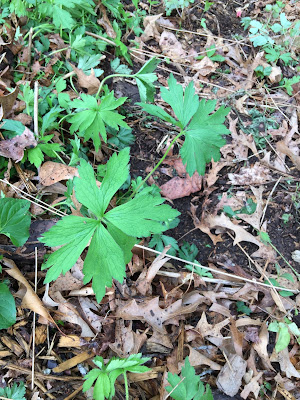A plant mystery solved
Actually, it didn't require much investigation, simply finding the small propagation id tag at its base, but its identity had been puzzling us for days.
Resembling the leaves of Rudbeckia laciniata, the foliage was also reminiscent of geraniums, but the parent plant was much too robust for a geranium. We'd obviously planted it; it was in a prominent spot, with the stems from last year's flowers evident.
But what caught our attention is how many young plants had popped up in various spots nearby. Hmm, what the heck is this, we thought? How desirable is it? Did it just have exceptional germination success over a particularly wet year?
Our neighbor knew that it wasn't R. lacianiata, which she has in her garden, but she didn't recognize it, but when my gardening companion was moving volunteer seedlings around in the woodland garden again this afternoon, he found the tag.
Bingo! It's Tall Anemone, Anemone virginiana -- interesting. It's a widespread native of Eastern and Central North America in dry to moist woodlands -- but we clearly didn't have a strong "search image" result based on its leaves.
We'd almost certainly bought it at one of the Botanical Gardens at Asheville plant sales, probably from our native plant-growing friends who owns Natural Selections, a small nursery outside of Weaverville; It's on her inventory list.
Tim's now relocated the parent plant and many of its offspring elsewhere to more suitable locations in the back woodland. It'll be fun to see what they do this season.
Resembling the leaves of Rudbeckia laciniata, the foliage was also reminiscent of geraniums, but the parent plant was much too robust for a geranium. We'd obviously planted it; it was in a prominent spot, with the stems from last year's flowers evident.
But what caught our attention is how many young plants had popped up in various spots nearby. Hmm, what the heck is this, we thought? How desirable is it? Did it just have exceptional germination success over a particularly wet year?
 |
| leaves of our mystery plant |
Our neighbor knew that it wasn't R. lacianiata, which she has in her garden, but she didn't recognize it, but when my gardening companion was moving volunteer seedlings around in the woodland garden again this afternoon, he found the tag.
Bingo! It's Tall Anemone, Anemone virginiana -- interesting. It's a widespread native of Eastern and Central North America in dry to moist woodlands -- but we clearly didn't have a strong "search image" result based on its leaves.
 |
| Photo from the Wild Seed Project shop; click through to site |
We'd almost certainly bought it at one of the Botanical Gardens at Asheville plant sales, probably from our native plant-growing friends who owns Natural Selections, a small nursery outside of Weaverville; It's on her inventory list.
Tim's now relocated the parent plant and many of its offspring elsewhere to more suitable locations in the back woodland. It'll be fun to see what they do this season.

How interesting. Nothing like a plant mystery on a spring day.
ReplyDeleteI tried growing this plant, but it didn't like my garden. R. laciniata, on the other hand, makes itself right at home!
ReplyDelete